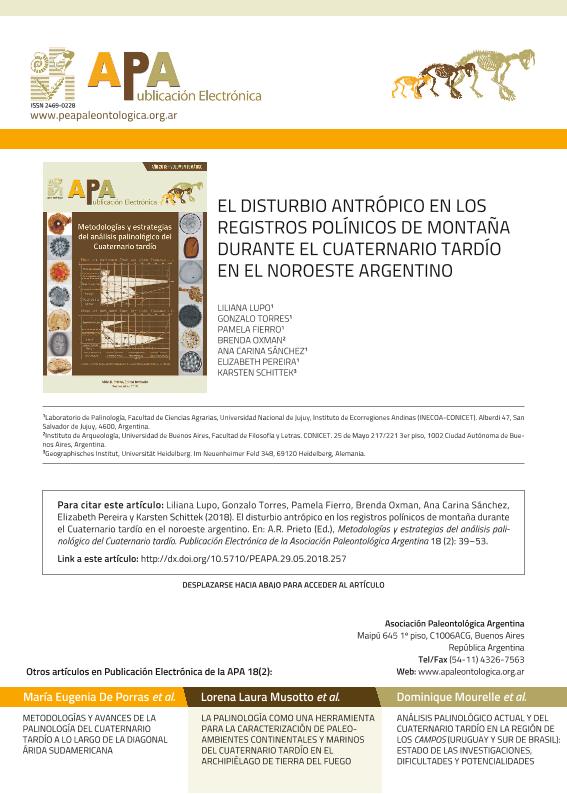Artículo
Para comprender el origen causal de lasvariaciones del paisaje y particularmente de las comunidades vegetales en los diferentesescenarios ambientales con larga historia de ocupación humana, como losecosistemas de montaña del Noroeste argentino, es importante integrarmetodologías que permitan ajustar la interpretación de los diferentes contextosambientales durante el Cuaternario tardío. En este marco, es fundamental elconocimiento espacio-temporal de las asociaciones vegetales/polínicas indicadorasde actividades antrópicas, con especial énfasis en la problemática de laaparición y desarrollo de los sistemas agropastoriles. Se analizaron datos de10 sitios (fluviales, lacustres, vegas, sitios arqueológicos), actuales yfósiles, datados por 14C. Se calculó abundancia relativa (AR),frecuencias de ocurrencia (FO) e índices de valor de importancia (IVI) de lostipos polínicos de la asociación indicadora de disturbio antrópico, comovariaciones y tendencias espacio-temporales. Se observaron la presencia dedisturbio por pastoreo/cultivos/malezas, destacándose los tipos de pastoreo ylas Amaranthaceae-Chenopodiaceae en todos los sitios. Se observa la tendenciaal incremento de rangos de disturbio en los archivos paleoambientales de Oestea Este, donde el Borde Oriental de los Andes concentra los mayores valores.Temporalmente, el Holoceno temprano presenta los rangos promedios más bajos dedisturbio, que aumentan desde el Holoceno medio al tardío. Estos resultados soncoherentes con los cambios regionales en el manejo y uso del espacio de sushabitantes durante el Holoceno en el NOA y Andes Centrales. To understand the causal origin of landscape variations and particularly plant communities in different environmental settings with a long history of human occupation, such as the mountain ecosystems of northwest Argentina, it is important to integrate working methodologies that allow for the adjustment of the interpretation of the different environmental contexts during the late Quaternary. In this framework, the spacetemporal knowledge of the plant and pollen associations that are indicators of anthropic activities is fundamental, with special emphasis on the problem of the appearance and development of agro-pastoral systems. Data from 10 modern and fossil 14C-dated sites (fluvial, lacustrine, peatlands, archaeological) were analyzed. Relative abundance, frequencies of occurrence and importance value indexes of the pollen types of the association indicating anthropic disturbance were calculated, such as space-temporal variations and trends. Grazing/crops/weeds represent disturbance, with the types of grazing and the presence of Amaranthaceae-Chenopodiaceae standing out in all the sites. Disturbance ranges increase in the paleoenvironmental archives from west-east, with the Eastern Cordillera of the Andes showing the highest values. Temporally, the Early Holocene presents the lowest average ranges of disturbance, whereas ranges increase from the Middle to the Late Holocene. These results are consistent with regional changes in resource management and land use during the Holocene in the northwest Argentina and the Central Andes.
El disturbio antrópico en los registros polinicos de montaña durante el Cuaternario Tardío en el Noroeste Argentino
Título:
Anthropic disturbance in mountain pollen records during Late Quaternary in Northwest Argentina
Lupo, Liliana Concepcion ; Torres, Gonzalo Román
; Torres, Gonzalo Román ; Fierro, Pamela Tatiana
; Fierro, Pamela Tatiana ; Oxman, Brenda
; Oxman, Brenda ; Sánchez, Ana Carina
; Sánchez, Ana Carina ; Pereira, Elizabeth de Los Angeles
; Pereira, Elizabeth de Los Angeles ; Schittek, Karsten
; Schittek, Karsten
 ; Torres, Gonzalo Román
; Torres, Gonzalo Román ; Fierro, Pamela Tatiana
; Fierro, Pamela Tatiana ; Oxman, Brenda
; Oxman, Brenda ; Sánchez, Ana Carina
; Sánchez, Ana Carina ; Pereira, Elizabeth de Los Angeles
; Pereira, Elizabeth de Los Angeles ; Schittek, Karsten
; Schittek, Karsten
Fecha de publicación:
03/2018
Editorial:
Asociación Paleontológica Argentina
Revista:
Publicación Especial - Asociación Paleontológica Argentina
ISSN:
2469-0228
Idioma:
Español
Tipo de recurso:
Artículo publicado
Clasificación temática:
Resumen
Archivos asociados
Licencia
Identificadores
Colecciones
Articulos(INECOA)
Articulos de INSTITUTO DE ECORREGIONES ANDINAS
Articulos de INSTITUTO DE ECORREGIONES ANDINAS
Citación
Lupo, Liliana Concepcion; Torres, Gonzalo Román; Fierro, Pamela Tatiana; Oxman, Brenda; Sánchez, Ana Carina; et al.; El disturbio antrópico en los registros polinicos de montaña durante el Cuaternario Tardío en el Noroeste Argentino; Asociación Paleontológica Argentina; Publicación Especial - Asociación Paleontológica Argentina; 18; 2; 3-2018; 39-53
Compartir
Altmétricas



